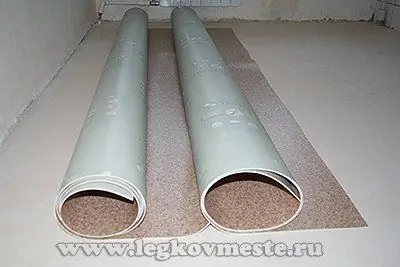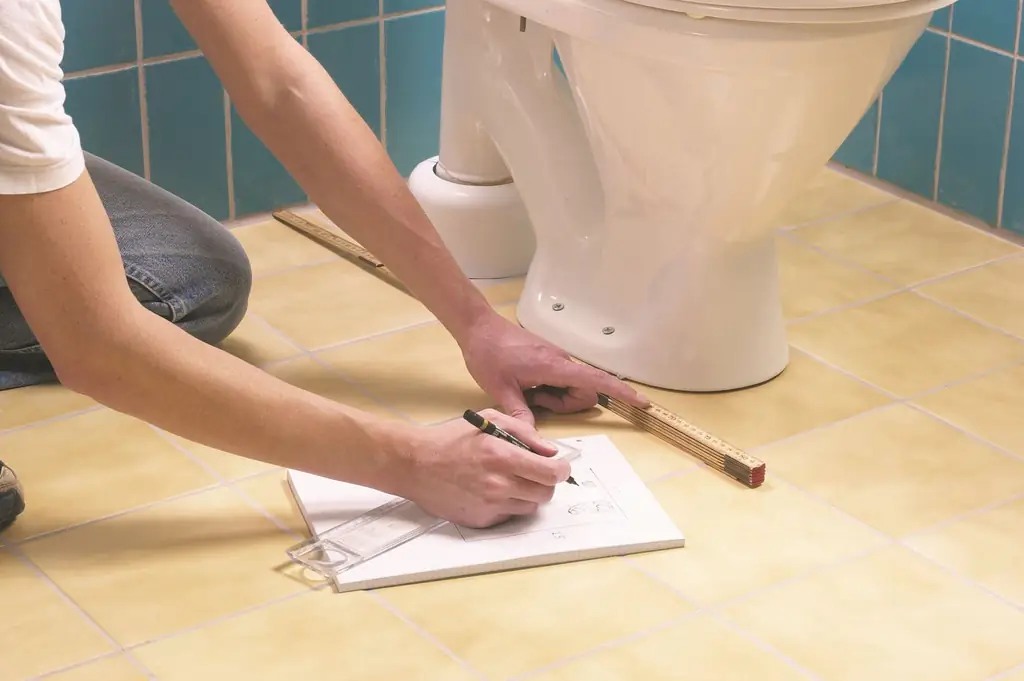
Table of contents:
- Not parquet, but no less beautiful! DIY laminate flooring
- Basic rules for the operation of laminate
- Materials and tools for laying laminate
- Laminate laying technology
- Rules for laying laminate diagonally
- Methods for laying laminate in non-standard situations
- What else is useful to know about installing laminate flooring?
- Video on how to lay laminate flooring
- Author Bailey Albertson [email protected].
- Public 2023-12-17 12:53.
- Last modified 2025-01-23 12:41.
Not parquet, but no less beautiful! DIY laminate flooring

Laminate is a great invention that allows you to decorate the floors in rooms as simply and quickly as possible. The shape of the lamellas and their configuration are carefully thought out, so even a beginner will not be difficult to mount it.
Since the elements of the laminate floor are simple to cut and combine, such a floor covering can be laid quickly even in rooms with complex layouts.
If you are interested in how to lay the laminate on your own, then our article will help you, guided by simple rules, to do this work quickly and correctly.
Content
- 1 Basic rules for the operation of laminate
- 2 Materials and tools for laying laminate
- 3 Technology of laying laminate
- 4 Rules for laying laminate diagonally
- 5 Methods for laying laminate in non-standard situations
- 6 What else is useful to know about installing laminate flooring?
- 7 Video on how to lay laminate
Basic rules for the operation of laminate
Before tackling laminate flooring, check to see if it is suitable for your environment.
- Installation work is carried out in a well-heated, dry room. To extend the life of the laminate, the room should be kept at a constant temperature of 15 to 30 degrees, and a humidity of 40-70%.
- The base for the laminate should be absolutely flat, that is, a wooden or concrete base, the maximum differences of which should not be more than 2 mm per 1 square meter, and slopes should not be more than 4 mm per 2 m. Significant irregularities should be leveled by forming a floor screed, or using a self-leveling floor system.
- Do not install the laminate on an electric underfloor heating: this will lead to drying out and deformation of the elements. Laminate flooring should not heat up more than 27 degrees from below. In this case, the use of hydraulic heating systems is allowed, which evenly distributes heat without overheating. Take into account the required distance between the bottom of the laminate and the underfloor heating surface - at least 3 cm.

So, you have taken into account all the features and requirements, prepared the base of the floor. It's time to stock up on the necessary materials and tools.
Materials and tools for laying laminate
The technology for laying a laminate floor is simple. First, the substrate for the laminate (material - polyethylene foam) is laid on the prepared base, and then the elements of the floor covering are assembled. This option is suitable for wood floors. On a concrete base under the substrate, you will need to waterproof. A simple polyethylene film of 200 microns is suitable for it.
In order for the job to be done correctly, you will need the following:
- Laminate;
- Polyethylene film;
- Primer;
- Foamed polyethylene;
- Glue;
- Wedges for technological gaps;
- Plinth;
- Skirting boards;
- A hammer;
- Pencil;
- Roulette and building corner;
- Hacksaw (jigsaw);
- Construction knife;
- Wooden block.
Wedges can be purchased in the store, along with the laminate, or you can make it yourself by cutting the trims of laminate, drywall or lining into pegs 10-15 mm wide.

Glue is needed to secure laminate elements where edges and hooks are not enough.
After you have purchased everything you need, put the laminate in the room where you plan to install it for two days. This is necessary in order for the material to "get used" to humidity and temperature.
Laminate laying technology
First of all, thoroughly clean the floor surface from dust and debris. A construction vacuum cleaner will help you with this. Then prime the base, both wood and concrete. Wood floors can also be treated with an antiseptic.

- Lay a waterproofing film on the cleaned concrete surface, observing an overlap of 20 cm between the strips of material, and gluing the joints with tape. Lay polyethylene foam on top - a backing.
- Laying the laminate starts from the window, as a source of natural light.
- The underlay can be laid on the entire floor, or it can only be on a small area that you are covering at the moment, and then report as you progress. This way you will keep it intact and clean as you work.
- Make sure that the backing is 2-3 cm on the walls, thus forming a cushioning strip. Apply the next strips of material to the previous butt and secure with tape.
- The first lamella fits in the corner of the room from the window side. Pegs are inserted between it and the wall, also from the end. Now add solid stripes in the row to the end, checking the correct connection of the elements.
- At the end of the lamella there are grooves that allow you to bring the next element evenly at a slight angle, and tightly insert it into the previous one. This does not require much effort.
- The missing distance, in which the whole lamella did not fit, can be filled with a segment. Turn the lamella element over along the short end and place it on the already mounted area, resting against the wall. On the inside, you will see a cut line. Do not forget to leave a gap to the wall when marking, at least 10 mm. Cut the lamella to the required length with a hacksaw or jigsaw and insert into a common row.
- The second row should be laid without snapping the lock with the first row, but touching it over the edge of the end. Dock the entire row in the same way as the first, and when you completely assemble it, lift it and put it into the lock until it stops, snapping it in along the entire length. If in some places the lock is not fully engaged, attach a piece of wood and tap with a hammer.
Fill the entire floor space using this pattern. Any special work will be required in those places where there are communications, heating pipes, wall bends.
Rules for laying laminate diagonally
It turns out that this styling option is also quite simple. In addition, it visually enlarges the space of the room. The disadvantage of this method is the additional consumption of material. To roughly calculate the required amount, add 7-8% to the area of the room.

The preparation is no different from the one that is carried out before normal styling.
- Select a corner near the window and extend the fishing line from it with a slope of 45 degrees relative to the walls. It is on this line that you will subsequently navigate in order to align the laying of the lamellas.
- Cut the edges of the first strip at a 45 degree angle. Place the first strip in a corner with wedges to create a thermal gap.
- The next step: take two strips of lamellae and measure them so that their joint falls on the center of the first row, and the edges previously cut at 45 degrees are flush with the wall, taking into account the gap.
Thus, fill the entire floor. You can first lay out all the entire elements of the laminate, focusing on the joints and fishing line, and at the end of the work, fill in the sections near the walls with scraps. This option is preferable for a beginner in such work, since it avoids runaway at the joints of the rows due to uneven walls.
Methods for laying laminate in non-standard situations
Rooms with perfectly flat surfaces, without any protrusions or outlets for communications, are rare. Therefore, we are faced with the need to cut curly elements from lamellas. To do this, you will need:
- Pencil;
- Building corner;
- Construction knife;
- Jigsaw.
Here are a few options to help you cope with laminate flooring in challenging environments.
-
- To bypass the heating pipes, you need to trim the lamellas. Turn the element over in length, attach it to the laid ones, and using a corner mark the location of the pipes in width.
- After that, attach the lamella to the side of the pipe and rest it against the wall through the peg. Mark in this position the second mark with the building level (distance from the wall to the pipe). This way you get the intersections of the lines that define the locations of the pipe holes.
- Drill holes in the lamellas using special drills - "ballerinas". The diameter should be larger than the diameter of the pipes, the gaps can be closed with special inserts for laminate floors.
- Now cut the lamella in half across the middle of the hole. Attach one part to the rest of the floor to the pipe, and attach the other from the pipe to the wall. To make the fastening stronger, apply glue to the ends and press them together.
If the walls of your room have protrusions, cut the required shape with a jigsaw right along the lamellae. In cases where areas under heating radiators represent an obstacle, trim the bottom of the sheathing and roll the laminate board to the base of the wall, observing the gaps.

In order for the end of the lamella to be correctly inserted under the radiator or casing, you need to slightly tweak the lock of the adjacent lamella. To do this, carefully cut off the protruding edge from the bottom of the end. So that the strength of the joint does not suffer, coat the joints of the lamellas with glue and press firmly against each other.
What else is useful to know about installing laminate flooring?
If you are the happy owner of a living space with a large area, more than 8X8 meters, then laying a laminate floor will have certain features. You will need to form expansion joints. For this, use special profiles that are fastened to the floor between two unconnected sections of the assembled laminate.
In this case, the upper section of the dividing profile will be the same overlay as in the "pies" for doorways. The reason for this is the thermal expansion of the material and the need to limit the maximum area of the bonded section of the laminate floor in order to reduce the total deformation. The same profile must be installed along the boundaries of the separation of excellent loops of a warm water floor installed in the same room.

After you fill the floor completely and install the laminate in difficult places, remove any wedges installed around the perimeter and trim the edges of the underlay that protrude too much from under the surface. Leave only a couple of centimeters of front for the wall to provide a cushioning belt. Now all that remains is to install the plinth and the work will be finished.
The peculiarity of installing skirting boards on a laminate floor is that there are no attachments to the laminate and the floor, as such. The skirting strip is attached directly to the wall. There are several types of skirting boards and options for their attachment, so when installing, follow the manufacturer's instructions.
- Wooden skirting boards are only suitable for absolutely flat walls due to their hardness;
- If the wall surface is uneven, plastic skirting boards are optimal.
- If wires are laid under the skirting board, fix it in special grooves so that communications do not fall into the gap between the laminate and the wall.
- Place felt pads on the legs of all furniture in a room with a laminate floor.
In order for the laminate to serve you for a long time, protect it from moisture and temperature extremes. There are types of laminate flooring that are not afraid of external mechanical damage, but still such a floor requires careful handling: try not to allow the formation of scratches and chipped areas, they will harm not only the appearance, but also the quality of the material.
Video on how to lay laminate flooring
As you can see, assembling a laminate floor is not difficult at all, and you will see this in practice when you start the process yourself. We hope that our tips will help you avoid common mistakes. If you have any questions while reading the article, please ask them in the comments, and we will be happy to answer them. Surely, you want to share your experience with our readers. We wish you an easy job!
Recommended:
How To Properly Lay Linoleum On A Wooden, Concrete Floor, On Plywood With Your Own Hands In An Apartment, In A Room + Installation Video

Laying linoleum on the floor in an apartment with your own hands. How to properly lay material on different types of floors, without moving furniture, and cut it to the walls
Do-it-yourself Chimney Cleaning Using Potato Peelings, A Chainsaw And Other Methods, Including Folk, Instructions With A Video

You can maintain the chimney in the house yourself without resorting to the services of specialists. We will tell you how to clean the chimney with your own hands
How To Remove Iodine From Clothes And Other Surfaces, Than To Wash It From The Skin, Various Methods And Means + Video And Photo

How to remove iodine from different fabrics, wash stains from furniture, body and other surfaces. Effective ways with instructions for use with photos and videos
How To Remove Scratches From The Screen Of Technology: How To Remove Them Yourself, Reviews, Video

Damage to gadget screens and how to fix them. Improvised and special means, reviews. Preventing scratches on screens and plastic parts
Step-by-step Instructions For Self-selection And Installation Of A Toilet, Various Installation Methods + Video

Practical recommendations for self-installation of the toilet. Choosing a suitable toilet bowl, surface preparation. Different ways to install the toilet
